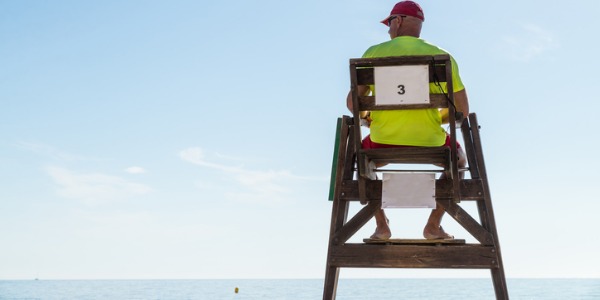What is a Lifeguard?
The idea of working as a lifeguard may conjure up an image of hunky guys and gorgeous girls who are tanned, muscular and beautiful and who perform daring Baywatch-style rescues along the beach. In reality, of course, the job is quite different from how it is depicted on television. Lifeguards come in all sizes and shapes, and they work inside as often as on the beach. It is, however, an extremely important job because it involves keeping people safe.
Lifeguards are expert swimmers who work at almost any location where people swim. They know how to save a person who is drowning or who has sustained an injury while swimming, and they can give artificial respiration if required. They keep a close eye on all the people under their care. The job of a lifeguard has a great deal of responsibility.
What does a Lifeguard do?

In general, a lifeguard monitors a recreation facility or a beach to make sure swimmers are following safety rules and no one is having trouble. He or she generally sits on a tall chair with a good view of the water and the swimming area. Binoculars are sometimes necessary, and if working outdoors, a large umbrella usually protects them from sunburn. Lifeguards working outdoors must also monitor the beach for hazards, such as sharks, jellyfish or stingrays, as well as dangerous waves and undertows.
Lifeguards may be responsible for designing activities for particular groups, such as seniors or children, and make sure any equipment used is kept organized and in good condition. They sometimes maintain sports equipment, are often in charge of keeping the pool area clean and safe, and are sometimes responsible for pool maintenance (for example, adding chlorine and pool chemicals).
Lifeguards sometimes give swimming lessons or teach safety classes. They may give demonstrations of proper ways to use equipment and educate people on swimming safety rules. They need to assess swimmer competency and make sure swimmers are not in an area of water depth that is beyond their skill level. An extremely important part of their job is safety. Lifeguards are trained in rescue and first aid techniques. They must explain safety rules to swimmers and enforce them. Should an accident or potential drowning occur, guards must administer first aid, rescue breathing, or artificial respiration.
What is the workplace of a Lifeguard like?
Lifeguards work in both indoor and outdoor locations. These can include schools and athletic departments, sports associations, community centres, summer camps, municipal parks, recreational facilities, beaches, resorts, and health clubs. There are also opportunities to work in hospitals and residential treatment facilities, helping individuals with special needs or the elderly.
Lifeguards may be exposed to the sun for long periods of time, and wind and inclement weather may also be a factor. Seasonal fluctuations impact the workplace, with greater employment opportunities during warmer weather, and work is often part-time. Although the workplace is generally safe, there are always risks around large bodies of water, and a lifeguard could be injured in the process of rescuing someone.
Frequently Asked Questions
Should I become a Lifeguard?
Perhaps the first fact to recognize about being a lifeguard is that it is not an easy job. It calls for a special skill set and, like most occupations, has its benefits and its drawbacks.
Requirements
You must be at least fifteen years old by the time you complete your training. You must be able to swim three hundred to four hundred yards; tread water for two minutes; hold your breath for two minutes; and grab a ten-pound brick from eight to twelve feet of water, with a feet- first surface dive. You must learn cardiopulmonary resuscitation (CPR), First Aid, and how to use an automatic external defibrillator (AED). You must be able to collaborate with team members and interact with people of all ages and personalities.
Benefits
Respectable pay Flexible work schedule in a casual environment Opportunity to gain extensive customer service experience Opportunity to learn responsibility and how to anticipate dangerous situations Opportunity to learn and practise lifesaving skills that can be valuable in other jobs and in life, in general
Drawbacks
Lifeguarding can be boring and tedious: the quiet, less busy days can feel extremely long. Lifeguarding can be annoying: there are days when ‘babysitting all of the neighborhood kids’ can become tiresome. Requirement to work in various types of weather
It should also be noted that, depending on their place of employment, lifeguards’ responsibilities may extend beyond the lifeguard chair. At some facilities, the role may involve regularly testing the water for chlorination or salinity, changing pool chemicals, teaching swimming lessons, cleaning the grounds, handling customer complaints, operating the cash register, and even cleaning restrooms.
What are Lifeguards like?
Based on our pool of users, lifeguards tend to be predominately investigative people. This finding is expected, as these practitioners are trained to effectively scan a body of water and the surrounding area to prevent and respond to emergencies. Their work is, by nature, investigative.
How long does it take to become a Lifeguard?
Becoming a lifeguard can take between two and six months. The shorter process applies to individuals who have already learned how to swim and can commence lifeguard training immediately. The longer time-frame includes approximately twenty to thirty hours of lessons over the course of three or four months to learn how to swim.
Steps to becoming a Lifeguard
In the simplest of terms, the route to becoming a lifeguard can be summarized as follows:
Be ready – with the ability to swim. Get trained – through the American Red Cross or another recognized organization. Start working – and maintain required certification.
Lifeguards are also known as:
Ocean Lifeguard
Pool Lifeguard
Beach Lifeguard